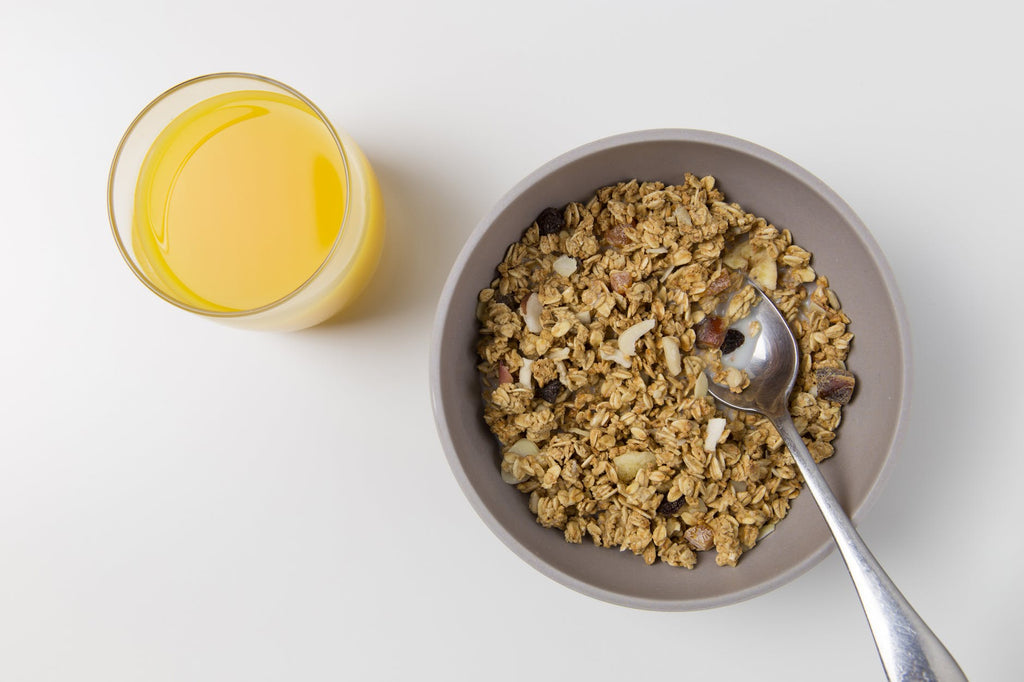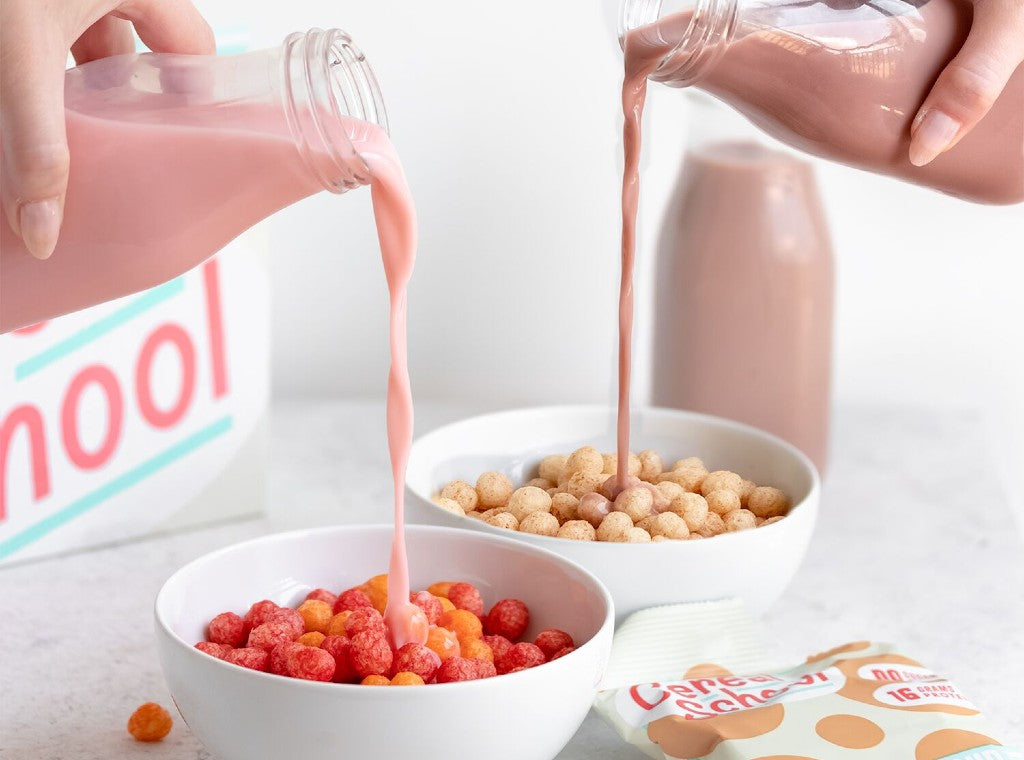
You've heard it all before: a good majority of breakfast cereals contain far more added sugar than you should be eating. The problem with too much sugar in your diet? Weight gain, diabetes, tooth decay, and so much more.
Case in point: You have a full bowl of cereal in the morning, but by 10 a.m. you're hungry and cranky. We’ll give you one guess as to why that happens. Yup. It’s sugar. (And don’t even get us started on the potential presence of weed killer in your favorite childhood treat.)
So, is cereal healthy? Well, it depends. With so many seemingly healthy cereals lining today’s grocery store shelves, it can be downright confusing about what’s fact and what’s fiction.
But don’t worry. That’s what we're here for. We did the legwork so you can get to the truth. And it’s all right here in this simple, easy-to-understand guide.
Read on to learn the top tips for making smarter choices and what to look out for when you’re on the hunt for a healthy cereal (that actually tastes good).
Healthy Cereal Tip 1: Beware of the Sweet Stuff
According to the American Heart Association, men should have no more than 37.5 grams of sugar (9 teaspoons) per day, while women should not exceed 25 grams (6 teaspoons) per day.
That all sounds well and good until you realize that the average sugar content for cereal these days is around 19.8 grams (5 teaspoons) per serving. And we won't even mention the fact that hardly any of us stick to the recommended serving size when having a bowl.
That means you'd have consumed just about all the sugar you should have in an entire day simply by having breakfast. Breakfast! The first — and most important — meal of the day. Where does that leave lunch, dinner, and snacks?
And when you consider sugar is also hidden in everyday, not-so-obvious foods like salad dressings, crackers, and bread, it's hardly surprising that the average American consumes three pounds (6 cups) of sugar a week. That's a whole lot more sugar than experts recommend.
So you might be wondering, what's the big deal about sugar? To start, it's nothing but empty calories, which means it has no health benefits whatsoever. On top of that, eating too much sugar for too long can lead to type 2 diabetes, heart disease, and other serious health problems.
With that in mind, the next time you're shopping for cereal — or any packaged food for that matter — be sure to check the ingredient list. If you see sugar listed as one of the top ingredients, stay far away. And don’t be fooled if you don’t actually see the word “sugar” — companies are getting mighty clever about that.
There are more than 60 different names for sugar including agave nectar, barley malt, cane juice, corn syrup, and dextrose. (And that’s just the first few letters of the alphabet!)
One more thing: Just because it says "low-sugar" or "sugar-free" doesn't automatically make it healthy.
Many sugar-free foods are loaded with artificial sweeteners, which is just as bad for you. A healthier cereal option would be something that uses natural sweeteners with low- or zero-glycemic levels, such as stevia or monk fruit.
Foods with low glycemic levels ensure your blood sugar rises at a slow and steady rate, which means no mid-morning sugar crash.
Healthy Cereal Tip 2: Choose Whole Grains

The American Heart Association Eating Plan suggests people should be eating 25 to 30 grams of fiber a day. Fiber is found mainly in fruits, vegetables, whole grains, and legumes.
A high-fiber diet not only prevents and relieves constipation, but it also provides health benefits such as helping to maintain a healthy weight and lowering your risk of diabetes, heart disease, and some types of cancer.
The problem is that while many breakfast cereals today may list "whole-grain oats" or "whole-grain wheat" as the first ingredient, many are still highly processed.
Take General Mills' Cheerios, for example. While it's made from whole grains, that's all ground into flour and then transformed into those cute little O’s everyone seems to love. The problem is, the grinding process strips out most of the fiber, greatly reducing any of the benefits you’d get from eating whole grains.
No wonder most Americans are only getting about 15 grams of fiber a day — just half of what we really need for optimal health.
To increase your fiber intake, look for whole-grain cereals that are made from the following:
- Whole-wheat flour
- Brown rice
- Whole-grain granola
- Barley
However, it would be even better to go for unprocessed whole grains, which are higher in fiber and packed with other important nutrients such as B vitamins, iron, folate, selenium, potassium, and magnesium. When shopping, look for cereals with the following ingredients:
- Steel-cut oats
- Rolled oats
- Quinoa
- Buckwheat
If that sounds a little boring, you can jazz up your cereal with nuts (which are loaded with healthy fats) and fresh low-sugar fruit like raspberries, strawberries, or blueberries. Avoid adding dried fruit if you can since it typically has a much higher concentration of sugar (and oftentimes sulfites and other preservatives).
Healthy Cereal Tip 3: Make Sure It's High-Protein
How much protein you should consume varies depending on your gender, weight, and whether the most strenuous activity of your day involves a two-mile run or a two-season Netflix binge.
For example, if you're a 5-foot-5-inch, 150-pound female who has a sedentary office job, you'll need at least 55 grams of protein a day. On the other hand, if you’re a 6-foot, 225-pound male athlete who works out regularly, you’re going to need considerably more protein.
But what does protein actually do? Protein is the key macronutrient that helps you feel full — and stay full. Not only that, research has shown that a high-protein breakfast can help you make better food choices throughout the day and also reduce your risk of type 2 diabetes and heart disease.
But before you think the only way to add more protein to your diet is to ditch breakfast cereals altogether, let us assure you that high-protein cereals do exist. They're probably just not the types of cereal you grew up with.
Think Kashi GO Crunch, Honey Almond Flax, Cascadian Farm Purely O's, and of course, our very own favorite — The Cereal School.
The next time you're buying cereal, take a look at the ingredients list and pay attention to how much protein there is. High-protein cereal should pack in more than five grams per serving.
Is Cereal Healthy? The Cereal School Is

Well, there you have it. Now you know what it takes to make cereal healthy and you can understand why we think The Cereal School is easily the healthiest cereal around.
First of all, there's absolutely zero sugar in our cereal. All that sweetness you taste is thanks to monk fruit, a natural sweetener from Mother Nature. We disapprove of anything artificial and use only natural, non-GMO ingredients, with absolutely no preservatives.
It's part of the reason why our cereal is as low-carb as it gets (just one gram, to be precise). Paired with almond milk or Greek yogurt, it's a tasty morning meal — or midday snack or after-dinner treat — that can be part of your healthy eating plan.
We've also packed in 16 whole grams of protein for each serving, ensuring you’ll feel happy and full without that mid-morning crash.
And since our cereal is completely gluten-free and grain-free, it doesn't contain any of the common ingredients that are often sprayed with weed killer.
As an added bonus, Cereal School doesn’t just make for a healthy breakfast, it's crunchy, tasty, and convenient. Our cereal has all the flavor of your favorite childhood brands minus the potential for heart disease or type 2 diabetes.
So, is cereal healthy? If it’s low in added sugars, high in protein, all-natural, and free from any artificial ingredients whatsoever, then the answer is a resounding, delicious yes.



